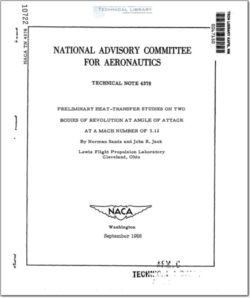NACA-TN-4378

- Version
- 143 Downloads
- 1.57 MB File Size
- 1 File Count
- March 24, 2016 Create Date
- March 24, 2016 Last Updated
National Advisory Committee for Aeronautics, Technical Notes - Preliminary Heat-Transfer Studies on Two Bodies of Revolution at Angle of Attack at a Mach Number of 3.12

Local rates of heat transfer were obtained for a cone-cylinder model
and a parabolic—nosedrcylinder model at a Mach number of 5.12 and angles
of attack up to 18°. Data were obtained for cooled surfaces at unit Reynolds
numbers of 0.56 and 0.65 million per inch based on free—stream conditions.
Zero angle of attack data are included for comparison.
Fbr similar type boundary layers heat-transfer coefficients at angle
of attack were always higher than those at zero angle of attack at cor—
responding geometric locations. On the windward side Stanton numbers
increased steadily with angle of attack; however, no systematic variation
of Stanton numbers with angle of attack was found on the sheltered side.
The parabolic forebody showed the following advantages over the con-
ical forebody: (a) it increased the extent of laminar boundary layer on
the windward side of the model, and (b) it reduced the Stanton numbers
on corresponding geometric locations of the two models (when the models
possessed similar type boundary layers), except on the leeward side where
no definite advantage was evident due to forebody geometry.
Heat—transfer coefficients along the most windward and most leeward
generators were approximately equal near the tip of the models at all
test configurations. Toward the aft part of the models, however, the
ratio of Stanton numbers along the most leeward to those along the most
windward generators at equivalent distances from the tip was between 2
and 5 at 50 angle of attack, and gradually decreased to a ratio of ap—
proximately l/Z at 18° angle of attack.
Within the range and accuracy of the investigation, the unit Reynolds
number did not have a significant effect on the values of the Stanton
numbers along the most leeward generator of both models.
The problems associated with aerodynamic heating of an axisymmetric
body at zero angle of attack have been extensively studied, both theore—
tically and experimentally. The problems inVolved, however, increase in
complexity when the body is subjected to some angle of attack with respect
to the undisturbed free stream.
| File | Action |
|---|---|
| naca-tn-4378 Preliminary Heat-Transfer Studies on Two Bodies of Revolution at Angle of Attack at a Mach Number of 3.12.pdf | Download |

Comment On This Post